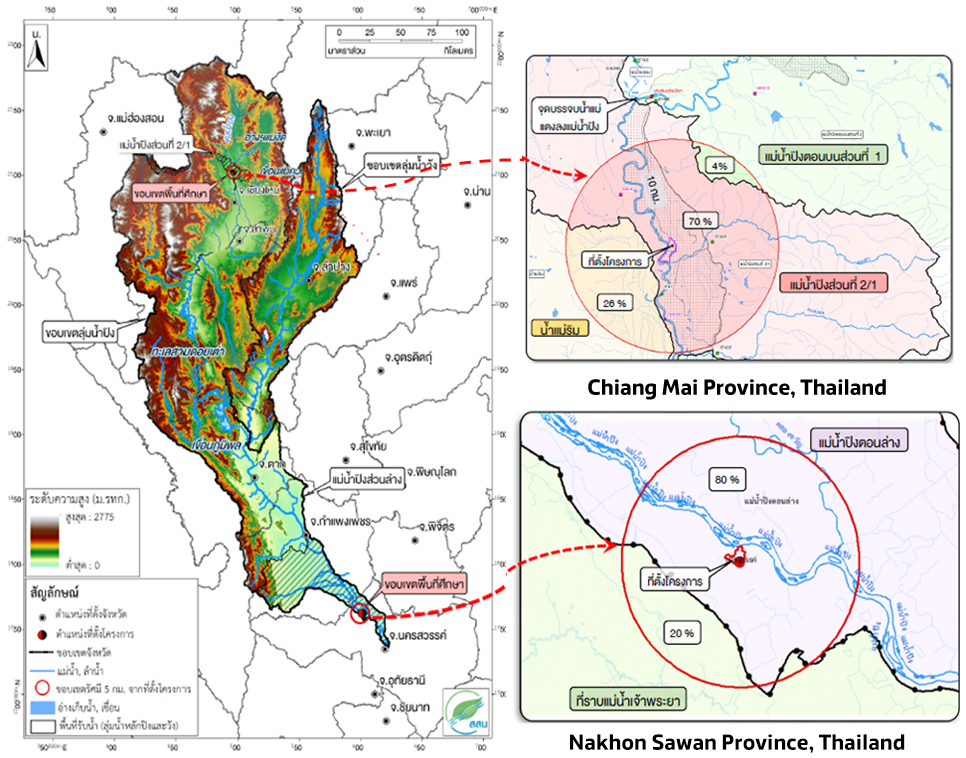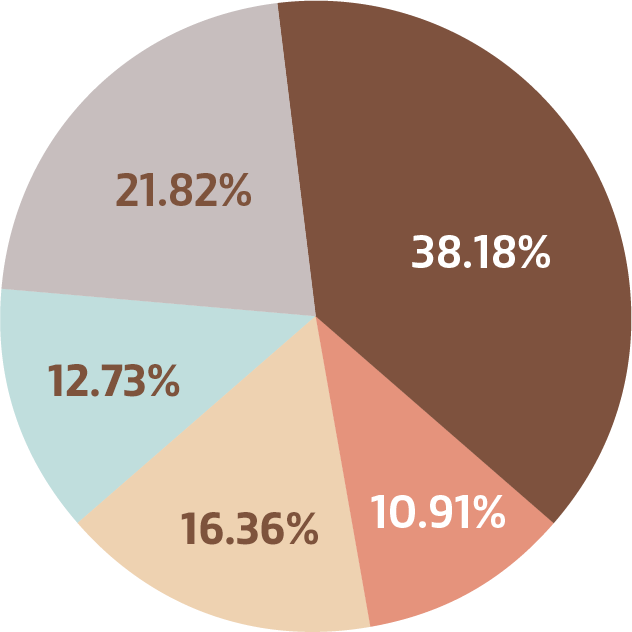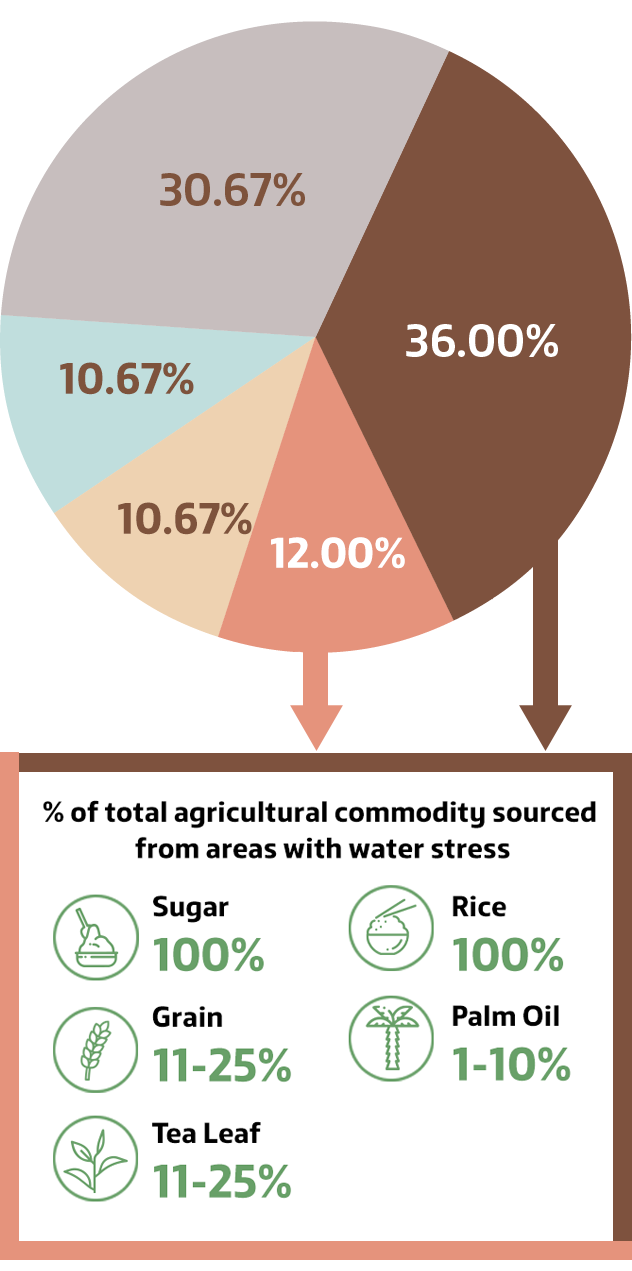ThaiBev regularly conducts a Water Sustainability Assessment (WSA) covering both surface water and groundwater resources at production facilities to identify any potential impacts and risks associated with its business units.
This in-depth assessment covers four dimensions:
- Detailed water source assessment, including the availability and internal structure of water resources.
- The vulnerability of the watershed, considering both social and environmental factors.
- Water-related natural occurrences, such as droughts and floods, etc.; and
- The quality of water sources.
This assessment covers a period of five years to ensure there are sustainable water supplies to support the facilities’ operations. Processes in the study include: water sufficiency, water quality, rules and regulations related to water resources, and stakeholders’ perception.
ThaiBev production plants to track and monitor water availability by obtaining water data from National Hydroinformatics Data Center (refer to
https://www.thaiwater.net/) and compared this data against own data on forecasted water demand, water inventory and the likelihood of water shortage on a monthly basis and reported to the Product Group’s risk coordinators. The Product Group’s risk coordinator shall review all water data reports from each production plant and analyze water-related risks as well as set mitigation plans and initiatives. The water-related risks considered material shall be brought up to the Corporate Risk Management Team for further action.
- ThaiBev production plants to perform daily monitoring of the quality of water supply and effluent following ISO 9001 and ISO 14001 guidelines.
- The production plants located along the Chao Phraya and the Tha Chin River basins will have to monitor closely on the surface water quality during dry season starting from the month of November to April or even up to June as the plant operations may experience the saltwater intrusion from the Gulf of Thailand which can have major impacts on surface water quality. The production plants will have to use groundwater as a replacement for surface water due to water standard requirements, which increase its operating costs. In order to cope with the surface water shortage due to extreme climatic events, the plants will have to increase the freshwater storage capacity and improve the existing groundwater borewells.
- Groundwater is the second largest source for water withdrawal. Some ThaiBev production plants may be in the area designated as a critical zone by the Department of Groundwater Resource, which has the duty in controlling groundwater usage and mitigating environmental problems associated with it, due to groundwater depletion and saltwater intrusion, thus enabling the local authority to apply more stringent restriction on industrial water withdrawal of some production plants. The production plant to regularly monitor regulatory changes and prepare action to cope with the situation by implementing the 3Rs principles and the use of new technology, i.e. Reverse Osmosis (RO), increasing the use of recycled water, and reducing water withdrawal per volume of finished goods
- ThaiBev production plant to be a member of The Federation of Thai Industries (FTI), which will regularly updates all members on new regulations relevant to all types of industries via their website, e-mail, and regular meetings.
- ThaiBev production plant to set up a working group responsible for tracking and assessing compliance with any applicable water-related law and regulatory changes and reporting the potential regulatory changes or new regulations to the Product Group’s risk coordinator. At the corporate level, the Product Group’s risk coordinators shall gather, review data from all production plants, and the risks that are considered material shall be brought up to the Corporate Risk Management Working Team for further action.
- ThaiBev to employ third-party to conduct perception survey of community members surrounding the production facilities to better understand their perception about the water availability, the water-related impacts of the industry, and the way to mitigate such impacts.
- ThaiBev production plant to set up working group consistently engage with its stakeholders, for instance, community
perception surveys were conducted and meetings with communities’ leaders as well as local authorities are arranged regularly, to collect their feedback and comments about plant operation as well as respond to any concerns. The plant management team shall assess the survey findings as well as feedback and comments from stakeholders for any potential water conflicts and reports to the Product Group’s risk coordinators every month for mitigation plans and initiatives. Any potential conflicts considered material shall be brought up to the Corporate Risk Management Working Team for further action.
The Surface Water and Groundwater Sustainability Assessment allows ThaiBev to create a comprehensive risk mitigation strategy and action plan that is appropriate for local conditions while addressing both long-term and short-term water-related risks.
In 2022, ThaiBev collaborated with the Hydro-Informatics Institute (HII) on the “Water Resources Management for the Community” project to study and assess the risks of floods and droughts in both short and long terms, by using the HII’s Water Resource Information System for Sustainable Development. The initiative aims to support the management of water resources in local communities at our production facilities located in “high to extremely high water stress” areas, covering a radius of five kilometers around each facility.
The study process is as follows:
- Study the general condition of the area, the watershed condition, and meteorological and hydrological data, including potential sources of water pollution, to assess the flooding and drought situation and the historical occurrences of such events in the past.
- Study the impacts of climate change on flood and drought issues, including the indices and trends in extreme rainfall data for current and future conditions. Create a probability map for extreme rainfall index values in the catchment area and its associated watershed areas around the facility.
Beer Thai Brewery, Kamphaeng Phet Province
The study was first conducted at Beer Thai Brewery in Kamphaeng Phet Province covering a radius of five kilometers around the facility. The results showed that the study area as a whole is at low risk of flooding and drought. Only about 3% of the area is at high drought risk, which could result in insufficient water to meet production and community demand. Through this initiative, ThaiBev will be able to operate its business and create value for the communities that share the same water sources.
In 2024, ThaiBev expanded the “Water Resources Management for the Community” project to the production facilities in Chiang Mai, Nakhon Sawan, and Lampang Provinces, which are also located in extremely high water stressed areas.
Site survey and interviews with the stakeholders in both upstream and downstream areas have been conducted to obtain the physical characteristics and areas that have previously experienced flooding and drought.
The location for site surveys include Upstream, and Downstream areas covering a radius of five kilometers around the facilities.

Thanapakdi, Chiang Mai Province
The initial findings from site surveys and interviews with the stakeholders in both upstream and downstream areas, including the water routes and flow directions, provide valuable information for effective water management.
Simathurakij, Nakhon Sawan Province
The initial findings from site surveys and interviews with the stakeholders in both upstream and downstream areas, including the water routes and flow directions, provide valuable information for effective water management. By comparing the land used maps from 2009 and 2022, the community areas, agricultural areas, and miscellaneous areas show a decreasing trend while the water areas show 0.72% increase.
HII will further analyze the impact of climate change on flood and drought risks through the simulations of future precipitations. Through this initiative, ThaiBev will have a mitigation action plan for water-related risks within and outside its operaions in order to effectively support communities
ThaiBev has received the Water Footprint of Product (WFP) Certification from the Water and Environment Institute for Sustainability (WEIS), a division of the Federation of Thai Industries, for its Crystal drinking water. This certification was achieved by accurately assessing the company’s commitment to the principles of Life Cycle Assessment (LCA) throughout all stages of the product lifecycle, including raw material acquisition, processing and manufacturing, distribution and transport, product use phase, and disposal of product debris after use. The evaluation measures the amount of water consumed and polluted throughout the full production cycle from the supply chain to end-user. A product water footprint also provide information on the impact on freshwater resources.
The assessment of the total amount of water consumed or polluted, as reflected in the product water footprint, found that 60% of the water usage ratio comes from raw material acquisition and 40% from processing and manufacturing, with no significant impact from distribution and transport, product use phase, and disposal of product debris after use. This certification provides guidelines for the product’s water management and aims to enhance the efficiency of water resource usage. Moreover, it helps to identify opportunities for improving water efficiency, and reducing impacts on upstream, midstream, and downstream resources.
ThaiBev has demonstrated its commitment to sustainable water management by assessing its water usage through the Water Footprint of Product (WFP) certification.






